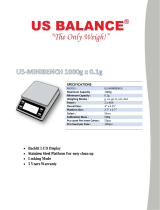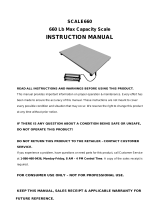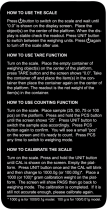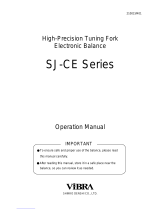Page is loading ...

USER
MANUAL
AKA SERIES
File: 2015-05-25 ALN Aln-01 GB

2 USER MANUAL
____________________________________________________________________________________________________________________
Contents:
1. General description ....................................................................................................... 4
2. Set ................................................................................................................................. 4
3. Safety rules ................................................................................................................... 5
4. Technical data ............................................................................................................... 6
5. General balance description .......................................................................................... 7
6. Keys and indicators ....................................................................................................... 9
7. Preparing working environment ................................................................................... 10
8. Preparing balance to work ........................................................................................... 11
9. General operation principles ........................................................................................ 12
10. Internal calibration ..................................................................................................... 13
11. Checking the balance ................................................................................................ 15
12. Connecting the balance to computer or printer .......................................................... 15
13. Start-up ..................................................................................................................... 19
14. Weighing with tare ..................................................................................................... 20
15. Scale menu ............................................................................................................... 21
16. Menu navigation rules ................................................................................................ 22
17. Scale setup (SEtUP) .................................................................................................. 28
17.1 Scale calibration (CALIb) .................................................................................... 29
17.2 Autozeroing function (AutotAr) ........................................................................... 33
17.3 Weight unit selection (UnIt) ................................................................................. 34
17.4 Serial port parameters setting (SErIAL) .............................................................. 35
17.5 Printout configuration (PrInt) ............................................................................. 36
18. Special functions description ..................................................................................... 38
18.1 Product and user identification (Prod and USEr) ................................................. 39
18.2 Pieces counting function (PCS) .......................................................................... 41
18.3 Percentage weighing function (PErC) ................................................................ 42
18.4 Label choosing function (LAbEL) ........................................................................ 43
18.5 Weighing animals function (LOC) ........................................................................ 44

USER MANUAL 3
____________________________________________________________________________________________________________________
18.6 Constant tare memory function (tArE) ................................................................. 45
18.7 Maximum value indication function (UP) .............................................................. 47
18.8 Total weight function (totAL) ................................................................................ 48
18.9 Checkweighing function (thr) ............................................................................... 50
18.10 Setting date and time function (dAtE) .................................................................. 53
18.11 Statistical calculations function (StAt) .................................................................. 54
18.12 Function for summing recipe ingredients (rECIPE) .............................................. 57
18.13 Density determination (dEnSItY) .......................................................................... 58
19. Troubleshooting and maintenance ........................................................................... 61
Declaration of Conformity ............................................................................................ 62

4 USER MANUAL
____________________________________________________________________________________________________________________
1. General description
AKA/AKZ series balances are destined for high accuracy weighing in laboratory practice.
All balances are metrologically tested. According to an order balances can be calibrated or legally verified.
Balances with legal verification comply with certificate of type approval and are marked with the following
legal and securing items:
- green metrological mark placed on the balance name plate,
- notified body stamp (number of notified body) on the balance name plate,
- protective seals placed on: an edge of balance name plate, the casing mounting screw and in the place
of access to adjustment switch,
In order to renew legal verification please contact authorized service of AXIS.
Balance classification according to PKWiU: 33.20.31.
Certificates:
2. Set
A standard set consist of:
1. Balance,
2. Pan support and a pan,
3. Feeder 12V / 1,2A,
4. User manual,
5. Guarantee card
Certificate of ISO quality system Certificate of balance type approval
DIN EN ISO 9001:2000

USER MANUAL 5
____________________________________________________________________________________________________________________
3. Safety rules
It is necessary to follow safety rules of work with the
balance shown below. Obeying those rules is the
condition to avoid electrical shock or damage of the
balance or connected peripheral devices.
Repairs and necessary regulations can be done by authorised personnel
only.
To avoid fire risk use a feeder of an appropriate type (supplied with the
balance) and supply voltage have to be compatible with specified
technical data.
Do not use the balance when its cover is opened.
Do not use the balance in explosive conditions.
Do not use the balance in high humidity environment.
If the balance seems not to operate properly, switch it off and do not use
until checked by authorised service.
According to current acts of low about protection of
natural environment, wasted balances should not be put
into waste containers together with ordinary waste.
Wasted balance after operation period can be delivered to units
authorized for gathering wasted electronic devices or to the place where it
was bought.

6 USER MANUAL
____________________________________________________________________________________________________________________
4. Technical data
Type
AKA120
AKZ120
AKA220
AKZ220
AKA320
AKZ320
AKA520
AKZ520
Load (Max)
120g
200g
300g
500g
Load (Min)
0,02g
0,02g
0,02g
0,02g
Readout unit (d)
0,001g
0,001g
0,001g
0,001g
Verification unit (e)
0,01g
0,01g
0,01g
0,01g
Tare range
-120g
-200g
-300g
-500g
Accuracy
II
Repeatibility
0,001mg
Non-linearity
0,002mg
Work temp.
+18 ÷ +35°C
Weighing time
<3s
Pan size
115mm
Balance dim. (with legs)
215(235 with legs)x345x90mm
Interface and equipment
RS232C, USB, PS2, clock (option: LAN or Wi-Fi)
Supply
~230V 50Hz 6VA / =12V 1,2A
Scale weight
5kg
Recommended standard of
mass
F2 100g
F2 200g
F2 200g
F1 500g
Type
AKA1200
AKZ1200
AKA2200
AKZ2200
AKA3200
AKZ3200
AKA4200
AKZ4200
AKZ10
Load (Max)
1200g
2200g
3000g
4200g
10kg
Load (Min)
0,5g
0,5g
0,5g
0,5g
5g
Readout unit (d)
0,01g
0,01g
0,01g
0,01g
0,1g
Verification unit (e)
0,1g
0,1g
0,1g
0,1g
1g
Tare range
-1200g
-2200g
-3000g
-4200g
-10kg
Accuracy
II
Repeatibility
0,01g
0,1g
Non-linearity
0,02g
0,2g
Work temp.
+18 ÷ +33°C
Weighing time
<3s
Pan size
165x165mm
195x180mm
Balance dim. (with legs)
215(235 with legs)x345x90mm
Interface and equipment
AKA/G or AKZ/G: RS232C, USB, PS2, clock (optional: LAN or Wi-Fi)
AKA or AKZ: RS232C (optional: USB, PS2, clock, LAN or Wi-Fi)
Supply
~230V 50Hz 6VA / =12V 1,2A
Scale weight
5kg
Recommended standard of
mass
F2 1000g
F2 2000g
F2 5000g
Caution:
E2 is international symbol of calibration weight class according to O.I.M.L. Some requirements for weight
accuracy are connected with this class.

USER MANUAL 7
____________________________________________________________________________________________________________________
5. General balance description
AKA100-AKA520, AKZ100-AKZ520 balances:
1 – pan
2 – pan support
3 – pan ring
4 – display LCD
5 – keys
6 – rotating legs
7 – water level
8 – draft shield
AKA1200-AKA4200 , AKZ1200-AKZ10 balances:
1 – pan
2 – nuts (under pan)
4 – LCD display
5 – keys
6 – rotating legs
7 – water level
7
6
1
2
4
5
7
6
1
2
4
3
5
8

8 USER MANUAL
____________________________________________________________________________________________________________________
Connectors view:
Feeder
~230V/50Hz
Printer
or computer
ON
OFF
Adjustment
switch
RxD (receiver)
TxD (transmitter)
GND
Case
RS232C
Feeder
1
2
3
4
5
6
7
8
9

USER MANUAL 9
____________________________________________________________________________________________________________________
6. Keys and indicators
Description of basic key functions and indicators:
T
- tarring (enter mass subtracted from weighed mass)/ confirmation of selected
menu options,
0
- zeroing (option),
- result printout (transmission),
- internal calibration,/ accelerated options viewing
- switch: special function/ weighing,
MENU
- enter to special function menu,
I/
- switch on / switch off (standby),
indicator
- shows stabilization of weighing result,
linear indicator
- indicator of balance load (0-100%),
OFF indicator
- appears after the balance is switched off with I / key,
distinction of last digit
- informs that reading unit value is lower than acceptable indication error
(balances with legal verification, de)
Max, Min, d, e, I
- metrological parameters of the balance.
The use of keys during entering numeric values (special functions):
- increment current digit,
- insert comma,
T
- move to next position,
MENU - finish entering.
0
kg
Max Min e= d= I

10 USER MANUAL
____________________________________________________________________________________________________________________
7. Preparing working environment
+18°C
+33°C
Location for the balance should be chosen with care in order to limit influence of the factors that can
interrupt working balance. This location has to maintain proper temperature for working balance and
necessary space for its operating. The balance should stay on stable table made of material that does not
influence magnetically on the balance.
Rapid air blasts, vibrations, dust, rapid temperature changes or air humidity over 75% are not allowed in
balance surrounding. The balance should be far from heat sources and devices emitting strong
electromagnetic or magnetic fields.

USER MANUAL 11
____________________________________________________________________________________________________________________
8. Preparing balance to work
1. Take the balance, the feeder and
mechanical elements of the pan out. It is
recommended to keep the original scale
package in order to transport the
balance safely in future.
2. Place the balance on a stable
ground not affected by mechanical
vibrations and airflows.
3. Level the balance with rotating legs
6 so that the air bubble in water level 7
at the back of the balance is in the
middle.
4. (for AGC100-AGC600) Gently insert
the mandrel of pan support 2 into
balance mechanism socket through the
pan ring 3 and the pan 1 on (AGC600
balances have not pan ring).
5. (for AGC1000-AGC4000, AGZ10C)
Place nuts 2 on mandrels that are visible
in balance cover holes, put the pan 1 on
nuts.
If the balance was taken from a lower temperature surrounding to a room with
higher temperature, e.g. in winter, moisture can liquefy on the balance casing.
Do not connect power supply to the balance, because this can cause damage
or improper work of the balance. In this case leave the balance for at least 4
hours unplugged for acclimatization.
7
6
1
2
3
7
6
1
2

12 USER MANUAL
____________________________________________________________________________________________________________________
9. General operation principles
1. Weighed sample should be placed in the centre of the pan.
2. Weighing result should be read when the indicator " " lights, which signalises stabilisation of a result.
3. The balance allows tarring in the whole measuring range. To tare the balance press
T
key (on the left
or on the right). Tarring does not extend measuring range, but only subtracts tare value from mass value
of a sample placed on the pan. To make the control of pan load easier and to avoid crossing
measurement range, the balance has a load indicator calibrated 0÷100% Max.
4. In direct sale use (d=e), make sure that zero indicator is displayed before sample is placed on the pan.
If not, press key and wait until the balance is zeroed and zero indicator appears. In other balances the
key does not operate.
5. When the balance is not used but should be ready to work immediately, it can be switched off by pressing
I/ key. The backlight of balance reading system is then switched off and the balance enters into
"standby" mode, in which the balance maintains internal temperature and ability to start working with
maximum accuracy. Standby mode is signalled by the OFF indicator. To switch the balance on press I/
key.
6. The balance cannot be used to weigh ferromagnetic materials due to decrease of weighing accuracy.
7. Balance mechanism is a precise device sensitive to mechanical shocks and strokes.
8. After every change of balance position, level the balance and perform internal calibration using key.
Do not overload the balance more than 20% of maximum capacity.
Do not press the pan with a hand.
For transportation take off the pan (move it gently and lift it up) and pan support (lift it up)
and protect from any damages.

USER MANUAL 13
____________________________________________________________________________________________________________________
10. Internal calibration
The balance is equipped with internal calibration system, which general task is to maintain required
measurement accuracy on the balance.
Internal calibration is the process of putting internal weight on automatically by balance mechanism and
correcting accuracy in balance firmware. The correction is necessary because of differences between
values of gravitational acceleration in the place where the balance was manufactured and in the place
where it is operated, as well as due to changes of balance level and temperature.
Internal calibration is performed in the following situations:
- when key is pressed,
- after defined time interval (for legally verified balances - 2 hours),
- after temperature change (for legally verified balances – more than 2
o
C).
In legally verified balances time interval is set to 2 hours and defined temperature change is 2
o
C. In not
legally verified balances those values can be set as calibration options. The reason of starting internal
calibration is shown as an icon near weight picture.

14 USER MANUAL
____________________________________________________________________________________________________________________
In order to perform internal calibration proceed with the following:
Empty the pan.
Press key twice (double pressing the key
helps to avoid accidental starting calibration
procedure).
During calibration internal weight is put three
times on and obtained results are compared.
Discrepancy of results is signalled with a
message and causes the balance being blocked.
Until calibration process is finished do not
perform any operation on the balance. Any
vibrations and shocks interfere calibration
process and may delay it or deteriorate accuracy
of its result.
When internal calibration is performed
successfully the balance indicates zero on the
display at empty pan.
Note:
In order to terminate calibration process in not
legally verified balances press key and wait
until balance mechanism is not settled in initial
position.
g
g
~45 seconds

USER MANUAL 15
_________________________________________________________________________________________________________________
11. Checking the balance
In order to confirm correctness of the balance during its operation, before starting and after finishing every
measurement series it is advised to check weighing accuracy. It can be done by weighing external
calibration weight or other object with exactly known mass.
If exceeding of allowable measurement error is affirmed, the following things should be checked:
- if the balance stands stable and it is levelled,
- if the balance is exposed on rapid air blasts, vibrations, rapid temperature changes or air humidity,
- if the balance is not affected directly by heat source, electromagnetic radiation or magnetic field.
The cause of inaccuracy can be too low temperature of the balance as well, when it was unplugged from
power supply. In this situation leave the balance switched on for several minutes in order to adjust its
internal temperature.
If none of above causes of inaccuracy occurs, calibration with external weight should be performed to the
balance. Recommended external calibration weight (to buy for additional charge) is given in technical data
table. In order to calibrate the balance with external weight in legally verified balances verification seals
should be removed and another legal verification should be performed. In this case it is recommended to
contact authorized service centre.
Calibration with external weight is described in details in chapter 17.1.
12. Connecting the balance to computer or printer
The scale can be equipped with one or two serial interfaces RS232C, USB, LAN or Wi-Fi designed to
cooperate:
- with computer – the scale sends data after pressing key or after initiation signal from
computer,
- with printer - sending data after pressing key or automatically after putting on/off a sample
and measurement stabilization,
- with label printer – after pressing the scale sends set of instructions for label printer starting
from label number set in special funcion LabEL.
Set of send data is set using special function PrInt.
The following data can be send:
- Header (scale type, Max, d, e, serial number),
- Operator identification number,
- Successive printout number (measurement),
- Identification number or product bar code,
- Number of pcs (PCS function only),
- Single detail mass (PCS function only),
- Nett weight,
- Tare (package mass),
- Gross weight,
- Total mass (Total function only).
The way of sending data and transmission parameters is set using SErIAL special function.

16 USER MANUAL
__________________________________________________________________________________________________________________
If the scale is equipped with two serial joints (interfaces) Print and SErIAL function is set independently for
both interfaces.
If scale cooperates with a computer then the computer must have a special program. Dedicated programs
are also offered by AXIS.
Needed drivers and instructions can be found on the CD supplied with Axis scales.
12.1 Detailed LonG protocol description
Standard communication parameters: 8 bits, 1 stop bit, no parity, baud rate 9600bps,
After using key, measurement data is send together with text description (NET, TARE, GROSS) – all
set by using Print option. If Print isn’t set then only scale indication is send (as below).
Data exchange (communication):
Readout of scale indication
ComputerScale: S I CR LF (53h 49h 0Dh 0Ah),
ScaleComputer: scale response according to description below (16 bytes):
Byte
1
-
sign „-” or space
Byte
2
-
space
Byte
34
-
digit or space
Byte
5÷9
-
digit, decimal point or space
Byte
10
-
digit
Byte
11
-
space
Byte
12
-
k, l, c, p or space
Byte
13
-
g, b, t, c or %
Byte
14
-
space
Byte
15
-
CR
Byte
16
-
LF
Attention:
Network number different than zero (SErIAL / nr function) changes scale working mode: communication
with a computer is possible after logging the scale in with 02h scale number command. To log the scale out
use 03h command.
For example: Using a program to test RS232 interface ( program is available in www.axis.pl / programy
komputerowe ) for scale number 1 please write: $0201 to log in, then SI, and write: $03 to close
communication.
Asking about scale presence in system (testing scale connection with computer):
ComputerScale: S J CR LF (53h 4Ah 0Dh 0Ah),
ScaleComputer: M J CR LF (4Dh 4Ah 0Dh 0Ah),
Displaying a inscription on scale’s display (text communicate from computer):
ComputerScale: S N n n X X X X X X CR LF, nn-displaying time in seconds; XXXXXX-6 signs to
display
ScaleComputer: M N CR LF (4Dh 4Eh 0Dh 0Ah),
Scale tarring (calling
T
key press) :
ComputerScale: S T CR LF (53h 54h 0Dh 0Ah),
ScaleComputer: without response,

USER MANUAL 17
_________________________________________________________________________________________________________________
Scale zeroing (calling
0
key press):
Computer Scale: S Z CR LF (53h 5Ah 0Dh 0Ah),
Scale Computer: without response,
Scale turning on / off (calling I/ key press):
Computer Scale: S S CR LF (53h 53h 0Dh 0Ah),
Scale Computer: without response,
Entering to special function menu (calling MENU key press):
Computer Scale: S F CR LF (53h 46h 0Dh 0Ah),
Scale Computer: without response,
Setting threshold 1 value (option):
Computer Scale: S L D1...DN CR LF (53h 4Ch D1...DN 0Dh 0Ah)
D1...DN – threshold value, maximum 8 characters („-” – negative value, digits, dot – decimal
separator), number of digits after dot should be the same as on scale display,
Scale Computer: without response,
Example:
in order to set low threshold 1000g in scale B1.5 (d=0.5g) the following order should be sent:
S L 1 0 0 0 . 0 CR LF (53h 4Ch 31h 30h 30h 30h 2Eh 30h 0Dh 0Ah),
in order to set low threshold 100kg in scale B150 (d=50g) the following order should be sent:
S L 1 0 0 . 0 0 CR LF (53h 4Ch 31h 30h 30h 2Eh 30h 30h 0Dh 0Ah),),
Setting threshold 2 value (option):
Computer Scale: S H D1...DN CR LF (53h 48h D1...DN 0Dh 0Ah),
D1...DN – threshold value, maximum 8 characters
Scale Computer: without response.
Setting threshold 3 value (option):
KomputerWaga: S M D1...DN CR LF (53h 4Dh D1...DN 0Dh 0Ah),
gdzie: D1...DN – threshold value, maximum 8 characters
WagaKomputer: without response.
Connecting cable WK-1 (scale – computer / 9-pin interface):
Connection cable WD-1 (connects scale with AXIS printer):
SCALE
KAFKA PRINTER
SCALE
COMPUTER

18 USER MANUAL
__________________________________________________________________________________________________________________
Setting of internal switches of AXIS printer:
SW-1
SW-2
SW-3
SW-4
SW-5
SW-6
SW-7
SW-8
on
off
on
off
off
on
off
off
12.2 Detailed EPL protocol description
Transmission parameters: 8 bits, 1 stop bit, no parity, baud rate 9600bps,
After using key in scale:
ScaleLabel printer : set of instruction in EPL-2 language that initialize label printing:
US
-
Steering instruction
FR"0001"
-
Label number define instruction
?
-
Instruction that starts list of variable signs
mm:gg
-
5 signs: minutes:hour
rrrr.mm.dd
-
10 signs: year.month.day
masa
-
10 signs: scale indication+ mass unit
P1
-
Steering instruction
Attention:
1. Except variable signs constant signs can also be inscribed e.g. factory name, product name and so on.
2. In standard only one label pattern is possible to printout (number 0001). Using bigger amount of
patterns (other label numbers) is possible thanks to LAbEL special function.
3. To achieve label printout, label printer must have inscribed label pattern (label pattern is created on
computer and using computer it is saved to label printer memory). Label pattern is designed by ZEBRA
DESIGNER program which is supplied together with label printer.
4. Scales parameters and transmission protocol must corespond to label printer type.

USER MANUAL 19
_________________________________________________________________________________________________________________
13. Start-up
Plug feeder into 230V power supply socket. When
the pan is empty plug feeder output connector into
12V socket at back of the balance. Autotests and
internal calibration will be performed.
Scale display test (autotests of internal electronic
elements C1:8 displayed only when any test result
is negative)
Displaying firmware version.
Test of internal calibration.
Internal calibration (in not legally verified balances
can be terminated using key – CAL End
communicate confirms).
After zeroing the balance is ready to weighing.
It is recommended before making measurements to wait until internal temperature of
balance stabilize. To accomplish that, the balance should be turned on for more than 2
hours before measurements. From the perspective of measurements accuracy
continuous balance operation is beneficial.
g
~45 seconds
0
Max Min e= d= I
kg

20 USER MANUAL
__________________________________________________________________________________________________________________
14. Weighing with tare
If the scale is not loaded and
0
indicator doesn’t indicate, press
0
key.
Zero indication and
0
indicator mean
that the scale is ready to work.
After putting container (package) tare the
scale using
T
key. NET indicator will
show up.
Put on weighted object and readout net weight
(NET indicator shows that scale indicates net
weight).
In order to readout gross weight press
key
(B/G indicator shows that scale indicates gross
weight). Press again
key in order to come
back to net indications.
00
g
g
g
g
g
/





